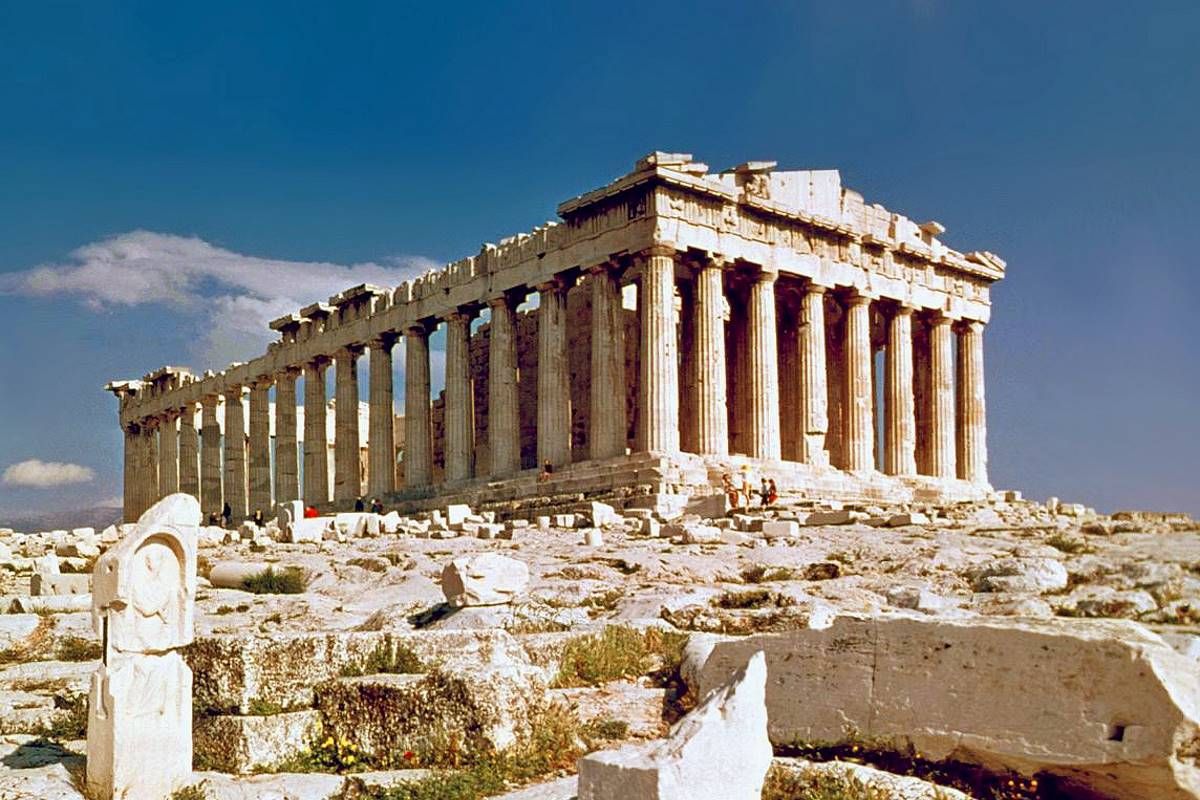History of the Acropolis

The Acropolis through the centuries
4000 BC: The first people of Athens settle around the Acropolis rock. Since that time and throughout Athens’ history the Acropolis was the center around which city life developed.
The Mycenaean period (1600-1100 BC):
The settlement grows and the rock, on which the king has its palace, was fortified in the 13th century. Cyclopean walls, that it walls made by huge stones, are raised around it.
Geometric and Archaic Period (9th-6th century BC):
The regime changes: aristocracy replaces monarchy. The Acropolis is no longer a fortress and the seat of the king and becomes the religious center of the city. In 566 BC, under the reign of Peisistratus, the Nea Panathenaea was established, the great festival in honor of Athena which took place every four years on the Acropolis. Temples, statues and numerous votive offerings are erected on the holy ground. In Around 525 BC Peisistratus’ sons built the ancient temple of Athena Polias in order to house the wooden statue of Athena sent by Zeus through the sky. This temple does not exist today.
The Golden Age (5th century BC):
After their victory over the Persians at the battle of Marathon (490) BC, the Athenians started building a temple in Athena’s honor to please their patron goddess. As a matter of fact, this was the first marble temple. It is known as the “Proparthenon” and it was never completed. In 480€ BC the Persians campaign against the Greeks for the second time and they torch Athens and the Acropolis. After the final expulsion of the Persians from Greece, in 479 BC (Batle of Plateaue), the Athenians wanted to repair the walls as soon as possible. So they used the ready-made building material provided by the unfinished or destroyed temples of the Acropolis. The destroyed sacred votive offerings of the Acropolis were buried in wells that they drilled for that purpose. Many of the monuments of the Archaic period that you will see at the Acropolis museum were found in such wells. It is the period of the great building program of Pericles and Phidias (Middle of the 5th century BC). During this century the southern wall of the Acropolis (Cimonio) was built and the Acropolis was expanded to the south. In order to increase and flatten the area of the Acropolis 200000 tons of earth and 100000 tons of stones were transferred. The area of the Acropolis increased from 9000 m2 to 34000 m2. Around 250 workmen worked continuously at the works on the Acropolis. Within a decade the rock has changed a lot and the Acropolis became the symbol of the classical culture. Nearly all the buildings that you see today on the Acropolis were built in the second half of the 5th century, during Pericles era.
The Hellenistic and the Roman Period (330 BC – 330 AD):
The Acropolis is full of numerous offerings. The Romans build the small temple of Rome and Augustus in front of the Parthenon, as well as a magnificent staircase leading to the Propylaea. In 267 AD the Herouli, a Barbaric tribe that invaded and looted Athens, set the Acropolis on fire.
Byzantine period (330 AD – 1204 AD):
Most of the monuments of the sacred rock are changed in to churches. The Erechtheion and the Parthenon are dedicated to Christ the saviour and the Athenian virgin respectively, while the Propylaea is used as residence of the Orthodox Metropolites of Athens.
Latin Occupation ( 1204 AD – 1458 AD):
The Propylaea becomes the residence of the Latin Princes and the Erechtheion is used as a residence and an underground reservoir. At the Propylaea the well known Franks’ Tower (26m high)
is built, which has been preserved till the present day. The Acropolis regains the role it had before the Classical period. Thanks to the shape of the rock and the heavy fortifications that are build around it (in reality they are the ancient walls coated with the rock and reinforced with new towers), the Acropolis becomes a fortified fortress with towers and bastions.
Turkish Occupation (1458-1821):
The most important monuments are converted into Muslim mosques. A minaret rises at the opisthonaos of the Parthenon. No damage so far has been so severe as the one that took place in 1687, during the second Venetian -Turkish War. The Venetians, under the leadership of Morosini, blow up the Parthenon, which was the Turkish storehouse of gunpowder. The whole roof comes down, as well large part of the sculpted decorations.
This was the beginning of the looting, in the beginning of the 19th century of the so-called “Elgin Marbles”. These were sculptures from the Parthenon which were removed by Lord Elgin and are still kept today at the British Museum.
Today, the Acropolis is an archaeological site where many restoration and maintenance works are conducted. Pollution is the “modern enemy” of the Acropolis, since it wears out the marbles.